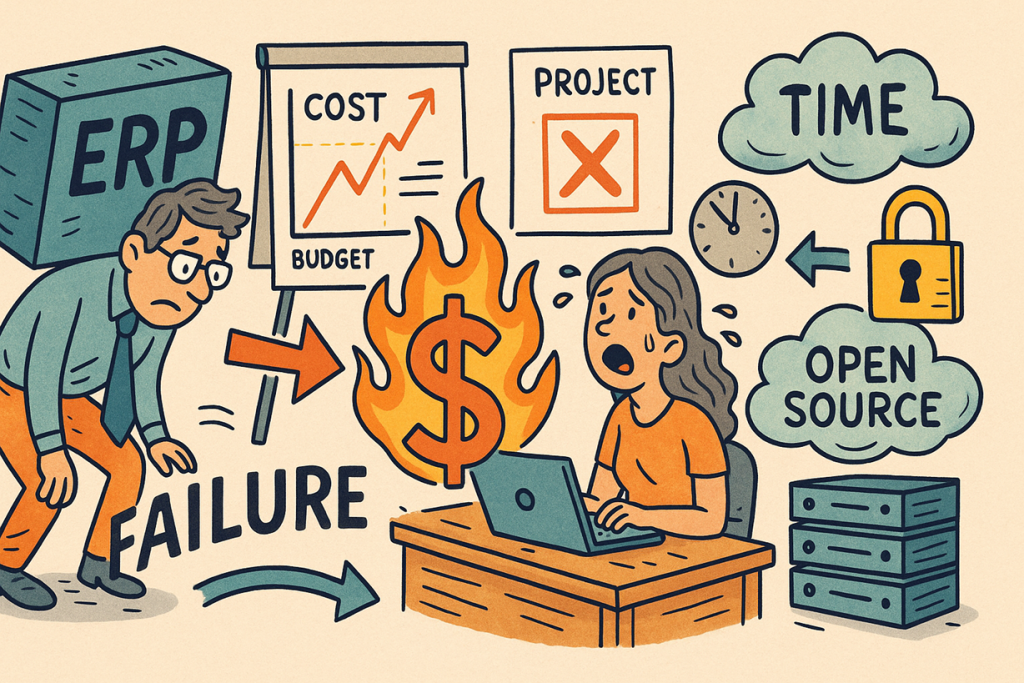
The True Cost of ERP:
Why So Many Projects Fail to Deliver—and What You Can Do Instead
Enterprise Resource Planning (ERP) systems were once hailed as the ultimate business solution—an integrated nerve center that could coordinate operations, streamline workflows, and boost productivity across departments. But for many organizations, the ERP dream has become a recurring nightmare of blown budgets, missed deadlines, broken promises, and mounting frustration.
Despite the billions spent each year on ERP implementations, a staggering number of projects fail to meet expectations—or fail outright. The question is no longer just “Can we afford an ERP system?” but “Can we afford the risk of another one?”
A Pattern of High Cost, Low Return
Let’s look at the facts:
- Over 55% of ERP implementations exceed their budget, according to Panorama Consulting’s 2023 ERP Report.
- Nearly half fail to deliver more than half of the expected benefits.
- Around 30% of projects are outright considered failures—abandoned, reversed, or so underwhelming that businesses revert to previous methods.
Why do these projects go so far off course? The reasons are as consistent as they are avoidable.
Why ERP Projects Go Sideways
- Rigid, Monolithic Software
Most ERP systems are designed with a “one-size-fits-most” philosophy. They’re built for industry averages—not the quirks and competitive advantages that define your unique business. As a result, companies are forced to change their operations to fit the software rather than the other way around.
- Customization Chaos
To bridge the gap between software and business reality, companies turn to customization—which quickly becomes a runaway cost center. Each modification requires specialized development, extensive testing, and often voids any chance of getting support from the vendor.
- Skyrocketing Implementation Costs
A typical ERP implementation costs 3 to 5 times the license fee, once you account for consultants, integration, and change management. But the biggest hidden cost? Internal staff time. Employees must spend weeks or months helping define processes, test configurations, and train peers—all while trying to keep the business running.
- License Fees That Never End
ERP vendors typically charge hefty recurring licensing and maintenance fees. Once you’ve sunk time and effort into implementation, switching becomes prohibitively expensive—making you a captive customer. Worse, you’re often forced into periodic updates that disrupt your systems and require retraining.
- Failure to Solve the Original Problem
In many cases, ERP systems don’t actually fix the issue they were brought in to solve. Whether it’s production forecasting, inventory optimization, or real-time reporting, the delivered solution is too generic, too late, or too misaligned with business needs to make a meaningful impact.
The Open-Source Alternative
The traditional ERP model is broken—not just because it’s expensive, but because it’s inflexible. That’s where open-source ERP systems offer a compelling alternative.
These tools offer:
- No licensing fees — drastically reducing total cost of ownership.
- Freedom to adapt — open codebases allow your team (or hired developers) to shape the system around your business, not vice versa.
- Community support — many open-source tools have robust user and developer communities sharing plugins, fixes, and best practices.
- Transparency — you own the code, the data, and the roadmap. No vendor lock-in, no surprise upgrades, no forced migration.
Of course, open-source solutions aren’t plug-and-play magic. They still require effort to configure, maintain, and support. But the difference is in control. You can move at your own pace, scale affordably, and customize without the bloat.
Conclusion: Think Beyond the Price Tag
ERP isn’t going away—but how we think about it must change. Businesses need systems that reflect their evolving processes, not ones that freeze them in amber. They need tools that empower employees, not consume them. And they need budgets that scale with value—not with complexity.
The open-source movement is no longer just for developers. It’s becoming a lifeline for business leaders tired of paying more and getting less.
It’s time to rethink ERP—not as a product to purchase, but as a platform to shape.
